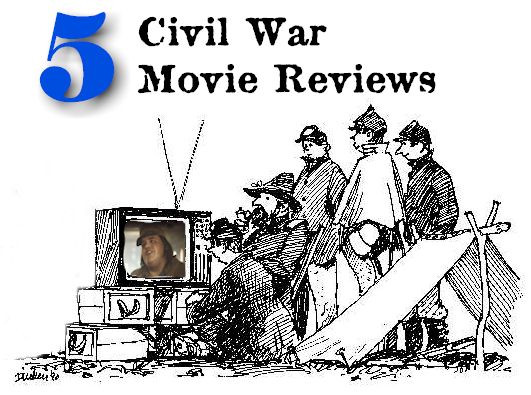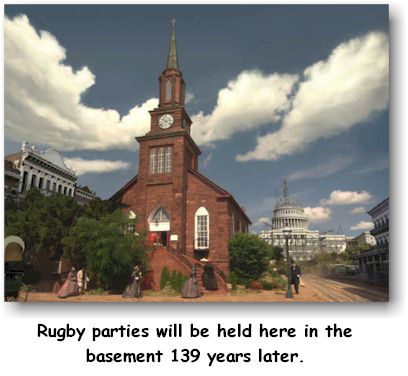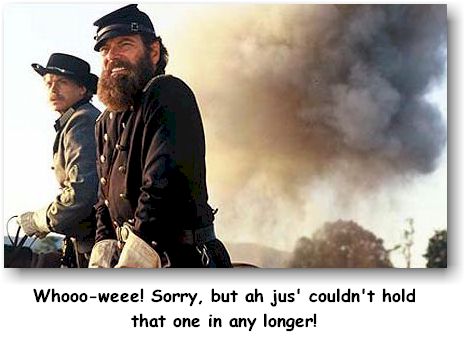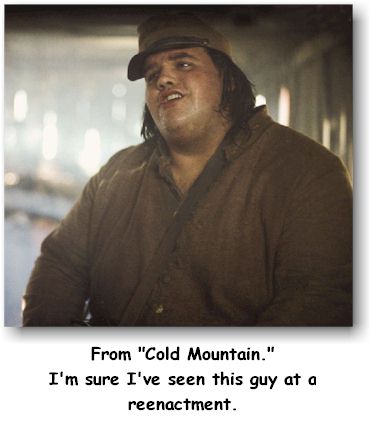
By Jonah Begone
Reviewed in the order I saw them, as a sort of stream-of-consciousness, running my mouth kind of thing for your reading enjoyment.
Manassas: End of Innocence (2002)
The
good news about this particular production is that it’s really the Manassas
Battlefield Park Visitors Center Video, so not only do you get to view it in a
dedicated auditorium with a state-of-the-art Dolby surround system, but you get
to walk the battlefield park as well!

(By the
way… over the many years I have visited battlefield parks dressed as a
uniformed volunteer and also as a member of the public, I have noticed that
visits to National Park Service property always go better when dressed in 21st
century mufti. I think dressing up as a reenactor tends to make the Park
Service people wary. Dressed as a normal citizen, I’ve always been treated like
more of a guest. Or at least like a paying customer. Anyway, take my word for
it and leave the wools behind.)
It’s
hard for me to focus solely on the film because, for me, it was part of the
greater experience of watching the film, going through the museum and then
walking the battlefield. The film works brilliantly at setting up the museum,
which has a number of the historical items used in the film on display. For
instance, above Judith Henry’s bed was a framed silhouette, which one could see
on display in the museum – very neat.
The
film looked very good – that is to say, it was well-photographed and had a
wonderful, modern high resolution image. The performances of the actors was
competent. I’m not a fan of Richard Dreyfuss, who did the narration – I find
his on-screen persona pushy and grating – but he did a good job with the
material. I think Dreyfuss has an interest in the Civil War. In 1989 he visited
a Cedar Creek battle reenactment, and toured the camps. He autographed the
inside of a pard’s forage cap upon request. “I’ll never wash it!” said the
pard. “Like you ever would anyway, or any part of yourself for that matter,”
quoth I. But I digress.
The
surround sound was wonderful – bullets whizzing all around. Ziiippp! Zinnnng!
Just like being there. I pointed out to my friend that I very much enjoyed this
kind of seated, air-conditioned reenacting. Why I wasted entire weekends in the
heat amongst the bugs doing it without the ziiippps! and zinnnngs!, I don’t
know.
The
images here, from matteworld.com, show how
downtown Manassas doubled as Washington D.C. for the film. See that church?
Back in April 2000 I attended a rugby party in the basement of that very
church, when it was an Irish pub. Earlier, we had played two tough 40-minute
halves with an aggressive team of Marines from the Quantico Rugby Football Club
(it remains the only time I have been constantly pushed back in a scrum), and
collected downstairs to give the owner’s wife Sheila a memorable
sight. “Hi, Sheila!”
No,
mine is not one of the butts on display. The very sight of it has been known
to… well… I ought not to say.
Getting
back to the subject at hand, save for the Johnstown Flood Visitors Center film
in Pennsylvania, which is truly gripping, this is probably the most ambitious
Park Service film, and worth seeing. Especially as a prelude to a day on the
park grounds.
Gods and
Generals (2003)
When this came out, the enthusiasm for the American Civil War, which fueled me for about fourteen years of reenacting, had entirely subsided. A brief review from a South Carolinian friend didn’t help, either: “It’s about Stonewall. Lots of praying and lemonade drinking.” Yawn. And reading Roger Ebert’s review convinced me that I shouldn’t waste my time – and a year passed.

And then I took a visiting friend from California out to the Antietam and Bull Run Battlefield Parks (see above) and, insidiously, the old interest in the American Civil War began to be revive itself. Who would have thought it? It’s like a refrain from a recent Tears for Fears song: Just when you think that it’s over/it’s not over/it’s not over… so, when a free Blockbuster coupon arrived in the mail I gave Gods and Generals a try over four nights. Which, given the film’s length, is the best way to view it.
The worst thing about this film was the dialog: stilted, ponderous and unnatural. Did human beings ever speak in that fashion? Really? It makes for impressive reading in books, but I can’t believe conversations were quite as, well, epic as this film insists they were. Everyone in this production talks as if he’s expecting to be quoted in future textbooks.
And that “Bonnie Blue Flag” song and dance sequence – that was just dreadful. I’m not certain whether it was included to give Ted Turner a horrible gratuitous cameo or to support a thesis that skinny, Joel Gray-style homosexual entertainment industry geeks got their start performing in Confederate camps. Whatever the reason, that was a scene that should have been killed in script reviews or film fragments left on the editing room floor.
Did they have to show Stonewall Jackson in bed with his wife? I mean, sure, historically they were married and all, but that was something I just didn’t want to see. It’s like seeing Abe Lincoln and Mary Todd Lincoln having pillow chat. It happened, but is there a clamor in America to view this in a film? Will future movie viewers have to suffer through nighty-night chats between Bill and Hillary Clinton? (Shudder.)
One more nit: The scenes of Confederates bursting out of the woods to attack the Union camps at Chancellorsville were great – but was that Mormon Tabernacle Choir style music really necessary? Hasn’t this turned into a movie cliché by now?
The best scenes in Gods and Generals are largely unspoken ones, which, as any good filmmaker knows, is characteristic of the medium. If the visuals are sufficiently interesting, dialog is unnecessary. My favorite scene of this type was after the battle of Fredericksburg, when Federal soldiers, trapped on the battlefield on a cold night, look up and see the Aurora Borealis, which made a rare southern appearance that night. While I suspect the lights weren’t quite as dramatic as portrayed in this film, it is a wonderous – and bizarre - sequence. The fact that it actually happened makes it all the more interesting.
Also simple, silent and impressive was the scene where a Confederate picket and a Union picket meet halfway across a river to exchange tobacco and coffee. You expect that they might try to make small talk, or discuss the progress of the war, but they don’t. No words were exchanged between them after their initial contact – and no words needed to be exchanged. This is good filmmaking.
I also enjoyed seeing Harper’s Ferry – a place I know well – stand in for Fredericksburg. As the producers claim, the place has a real 19th century “look” that would be difficult and expensive to build from scratch. (I especially enjoyed catching a fleeting glimpse of the red coffee mill sign at the little eatery of the same name, alongside the infamous “Hog Alley.”)
I have mixed emotions about the battle scenes. Sure, they looked impressive. As good or better than Civil War battles shown in any other film. But because this film has a PG-13 rating, what we saw was essentially a cheat. Saving Private Ryan raised the bar on showing combat in a film: bullets hit with squishing sounds, bodies get blown up in sprays of red and blood was flecked everywhere. That’s what happens on a battlefield. My view is that if you can watch a sustained sequence of filmed battle scenes without feeling a little bilious, what you’re seeing is an overly-sanitized version of combat. Sure, filmmakers want to be able to distribute their works to as wide an audience as possible – hence the PG-13 rating – but there is a inherent dishonesty about the battle scenes in Gods and Generals is that undermines the sense of fear, sacrifice and horror of the subject. On the other hand, my sense of indebtedness to the generation who fought in World War II is heightened by an honest film that shows something of what they went through – and this is Saving Private Ryan’s greatest attribute.
Yes, there are reenactor extras in Gods and Generals. Gosh, yes. We’ve been reading about them before filming, during filming and ever since. They’ve almost become celebrities in their own right. (“Why, yes, son, I was present at th’ Gods n’ Generals filming. Me an’ Marse Robert Duvall. Yep.”) And for the most part the reenactors in this movie unavoidably remind me of reenactors and not soldiers. I suppose that’s because mentally I expect that the real soldiers, like the ones in old photographs, are in black and white. You can spot some TBGs (tubby bearded guys) oddly appearing in the ranks of Lee’s famously scarecrow ranks; one middle-aged Reb, during Stonewall’s surprise attack, was filmed with a big grin on his face (made all the more hilarious by my DVD player’s ability to freeze and zoom on details).

Despite its faults, I found Gods and Generals
unexpectedly entertaining, and I think it’s probably a better film than most of
the reviewers say it is. Knowing something about the leftward political slant
of the entertainment industry in general, I suspect their dislike for this film
has as much to do with its politics (that is, portraying Confederates
sympathetically) as with its artistic demerits. In his review, Roger Ebert
invokes the names Trent Lott and Strom Thurmond and lets slip his anti-Southern bias. But in
my book, any film that makes liberals apoplectic has some value, so I’m willing
to give Gods and Generals this much.
And
loathe as I am to admit it, being a famous Union man, at the end of the film I found
myself pondering the noble natures of Thomas Jonathan “Stonewall” Jackson and
Robert Edward Lee. We could certainly use more men of that type in leadership
positions today. If this was a primary goal of the filmmakers, they have
succeeded.
Cold Mountain (2003)
You
know that scene in Gone With the Wind where the Yankee marauder stalks
up the stairs toward Scarlett with mischief in his heart? That’s pretty much
the starting point for this brutal film, which suggests that stay-at-home Rebs
were harder on enlisted Rebs than the Yankees were. Also, this film is rather
like O Brother, Where Art Thou? in that it, too, has an Odysseus
returning from the wars aspect. It also shares a Bluegrass music angle. (Jack
White of the White Stripes plays a Reb and sings some songs.) This is an excellent film, with some good
performances, but is somewhat hard to watch. The Battle of the Crater scene is
exciting, but I’m not so sure the crater was quite as packed with soldiers
as this film portrays. Perhaps somebody watched too much Lord of the Rings
and went overboard with the digital enhancements. Anyway, this film is
recommended.
(And if
you have daughters, you can point out Renee Zellweger and say, “This is what happens
to you if you eat too many doughnuts!”)
Gettysburg (1993)
When
this one came out, my interest in the Civil War was fading. Consequently, I
didn’t bother to see it when it was released. Yes, I know this is heresy. But,
in my defense, I will state that my enthusiasm for Civil War-related films was
tempered considerably by the passions of my fellow reenactors, many of whom
seemed to think that simply because reenactors were extras, the production could
be accorded the kind of legitimacy afforded to, say, Citizen Kane. One
oaf, playing the score for Glory on a boom box at an event, called it
“The Greatest Music Ever Written,” which certainly does an injustice to
Beethoven, Brahms and Bach. Upon stating this, he peered at me as if to see if
I intended to dispute him. Remembering the old quote about idiots – “Argue with
an idiot long enough and people will fail to see the difference” – I shrugged
and walked away.
Eleven
years passed by, and now the idea of watching Gettysburg is viable.
Desirable, even, since I’ve read that in comparison with Gods and Generals,
this is the better film. And it is. The dialog is unforced and natural, and,
generally, one is left with the impression that the Battle of Gettysburg was
big, tragic and impressive. The scenes with the 20th Maine at Little
Round Top is especially stirring – but then, I’m a Federal partisan and get
turned on by watching soldierly ranks of guys in navy blue blowing away Rebs.
Raises my Ebenezer, to use an old phrase.
This
film does have its faults, however. The main one has to do with that ridiculous
pelt hanging from Tom Berenger’s jaw, which earned this film the nickname
“Gettysbeard.” I suppose it could seem beardlike during Halloween, or if it
wasn’t in the context of a film obviously trying hard to look epic, dramatic
and authentic – but it fails. So no Oscar for Berenson’s beard. And there were
a few other offenders… J.E.B. Stuart has pretty artificial-looking facial hair
as well. It’s a good thing I wasn’t on the set; I’d be tempted to pull it
forward to see if it snapped back into place when I let go, like those gag
beards one sometimes sees.
And
while we’re on the subject of Civil War era facial hair, will you indulge me
for a moment? I am really, really tired of seeing big loutish guys (especially
rugby guys) sporting goatees, as if they were members of the court of Charles
I, or Musketeers. This whole goofy facial hair thing began in the Nineties, and
was soon followed by tattoos and shaved heads – the Inmate Look. Ugh. Did I
miss something? Who declared a new Uglification program for American males?
It’s time to let this horrible grooming fad die.
Thank
you. Now, back to Gettysburg.
The
thing other than Berenson’s beard that I found jarring in this film was that
the reenactor extras looked like, well, reenactor extras. I suppose it doesn’t
help that I recognized a bunch of them from reenacting (Bob Schindler, his
impressive real Beard and Demeanor on frequent display), but some of these guys
were too fat and too old to credibly portray soldiers. And don't even get me
started on the female musketpersons who, as usual, stood out like sore thumbs.
Too bad
they didn’t take impression lessons from the actor Sam Elliott (General John
Buford), who looked and sounded like a real solider. Wiry, intense and
muttering curses in his considerable mustache, this was one of the standout
performances in the film.
(This criticism doesn’t apply, however, to my pard Larry Sangi of the 15th New Jersey, who always looks credible. I am happy to report that he got a listing in the Internet Movie Database as “Soldier #3 20th Maine.” Cool. I look forward to seeing more of his films.)
The other problem I noticed is that reenactor extras aren’t
always credible actors. In the battle scenes some of them are just kind of
standing there looking like they’re unsure of what to do. Should I run at that
Reb with my rubber bayonet? Wait for the director to yell something? Hope these
guys around me move out of my way? Was this authentic combat behavior? Perhaps
it was. But in a film it sure is distracting. Maybe if this were an R-rated
film, with blood and guts being strewn about liberally, the reenactor actors
wouldn’t seem so tentative. After all, George C. Patton was giving excellent
directorial advice when he said, “When you put your hand into a bunch of goo
that a moment before was your best friend's face, you'll know what to do.”
What to say of Martin Sheen as Marse
Robert? I preferred Robert Duvall. But then, according to the IMDB he’s a
direct descendent of Confederate General Robert E. Lee so perhaps the superior
impression is genetic!
Perhaps
the biggest disappointment with Gettysburg has to do with something it’s
not responsible for: that celebrated Hancock party, where Lo Armistead bade a
fond farewell to Winfield Scott Hancock and everyone tearfully sang “Kathleen
Mauvorneen.” It
probably never happened. Too bad. I’ve always wanted to locate that place
in Los Angeles. Today, I suppose, that place is occupied by a skyscraper where
Hollywood executives are busy working on productions like Gettysburg, Cold
Mountain and Gods and Generals.
The Battle of Gettysburg (1955)
This
is a badly-dated 30 minute featurette that came with the Gettysburg DVD.
The acting is done by the statuary at the Gettysburg Battlefield Park. While
the performances are wooden (actually, “bronzed” might be a better term), the
uniforms are commendably authentic. Bombastic patriotic music plays every now
and then. There are many CinemaScope shots of swaying wheat, which might look nice
if you have one of those big plasma displays.
The
enduring image from this work is Robert E. Lee’s bronze head, sliding downwards
to the bottom of the screen like a setting sun in front of swaying wheat.
Associated articles on JonahWorld!
Turner takes a gamble on Civil War movie
Roger Ebert's Gods and Generals review
Civil War epic shut down by "PC crowd?"
